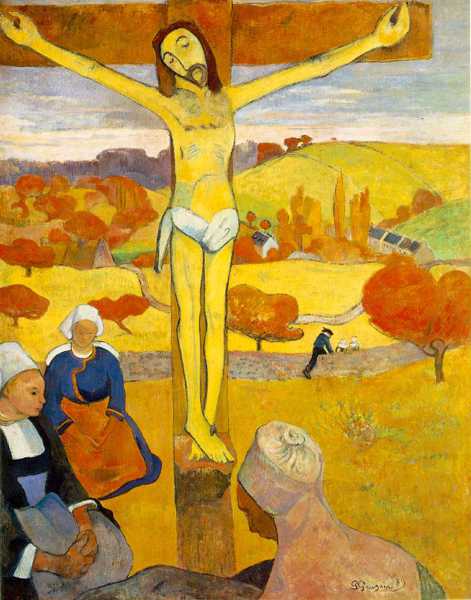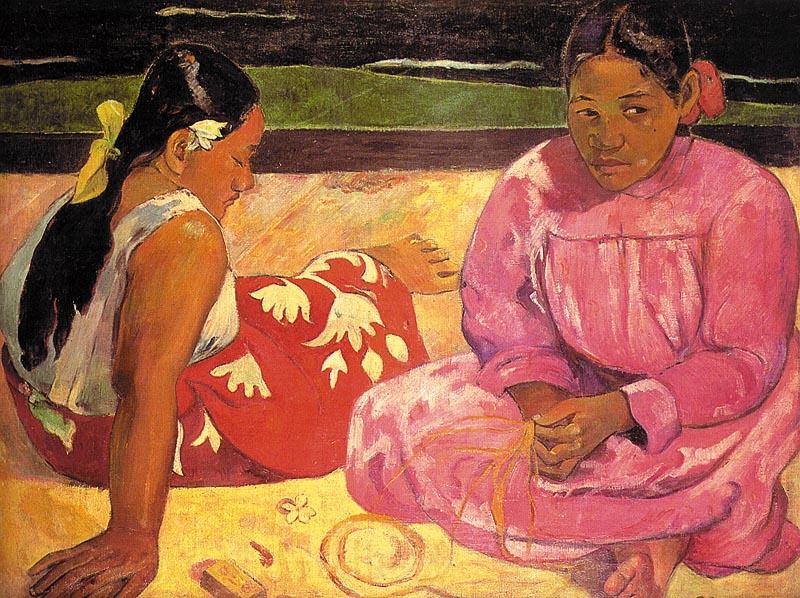In 1890, he decided to venture out on another trip. This time, to Tahiti. His work in Tahiti was manifested in his love of his tropical surroundings as well as his love for his new Synthetist techniques. He also became interested in Primitivism, an art form concerned with the expression of pre-civilized time and characterized by exaggerated body proportions, animal totems, geometric designs and stark contrasts. He was the first artist to utilize this style. After Tahiti, plagued with illness, Gauguin did little painting. He wrote literature and worked odd jobs here and there. Gauguin was a very complex man. He traveled often, seemingly unable to fit in anywhere. His art was influenced by this "bohemian persona" and the tropical, beautiful surroundings he placed himself in. Paul Gauguin died in May of 1903.
His art would later influence movements such as Fauvism and Cubism.
Styles and Techniques:
Impressionism: richness of light, blue and green shades on the naked skin in nude studies,
Synthetism:a simplification of forms, elimination of details to keep only essential forms, simplification obtained by use of thick contours and large flat areas of uniform color,
brilliant pure colors, flat planes of perspective, and "ornamental character of composition"
Primitivism: exaggerated body proportions, animal totems, geometric designs and stark contrasts
Pieces:
The Yellow Christ, Oil on Canvas, 1889 : Gauguin's purpose here was to convey the "great rustic and superstitious simplicity" which he saw in peasant folk. He used contour lines, pure color, a lack of shadow to add depth to the figures, and modeling to produce the painting and commentary on simple life. (Ideals of Primitivism)
from:http://johnmactaggart.com/art_appreciation/art_movements/post_impressionism.htm


 Gauguin, Paul: Self-portrait with Halo 1889, Oil on wood
Gauguin, Paul: Self-portrait with Halo 1889, Oil on woodfrom: http://jossefordart.typepad.com/art_journeys_and_conversa/gauguin_halo.jpg
This was described by people at the time as a caricature of Gauguin. The artist may be casting himself as satan in this: the apples are a fall from grace, the halo, the snake. Perhaps it is his own interpretation of the creation story.

Gauguin, Paul: Les Femmes de Tahiti, 1891
from:http://www.steveartgallery.se/france/picture/image-01330.html
This painting of two women from Tahiti, done early in his stay there further highlights his interest in primitivism.
I chose to do Paul Gauguin because I've always been very interested in the Fauvist movement and I know that he is one of the artists that greatly influenced that art form later in the 1900s. I enjoyed reading about his life's story and how it paralleled and contrasted to his interests in his art movements. He abandoned his family and his primitive lifestyle, yet he was very interested in primitivism. He was very ill and submitted to sadness and sorrow but he strove to use such bright, pure colors in his paintings. It's very interesting. I love using bold, bright color in my works and it was very nice to see Paul Gauguin's work in which he used colors to change his style and convey his messages.
Book Sources from Lilly:
Paul Gauguin from the Pocket Library of Great Art
Gauguin by Britt Salvesen
No comments:
Post a Comment